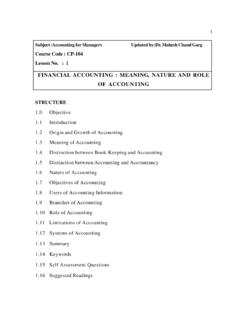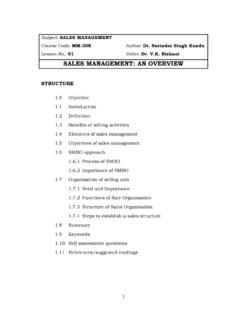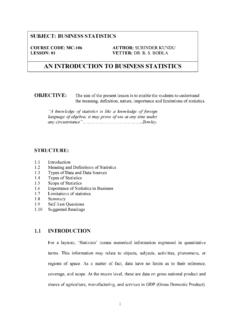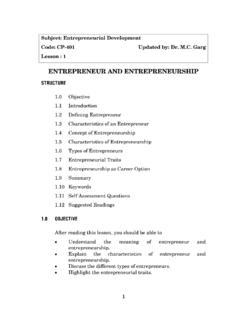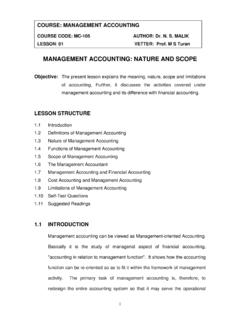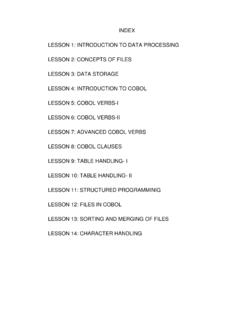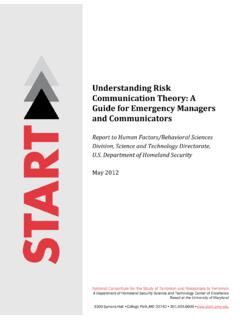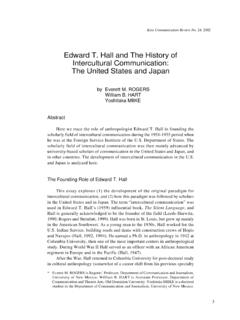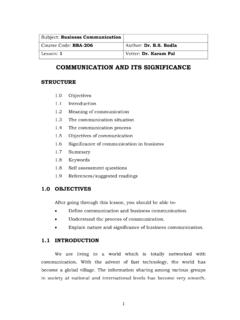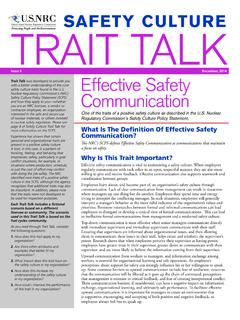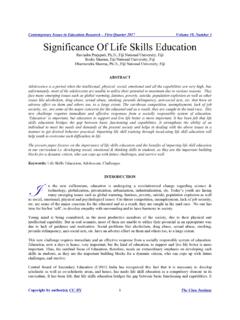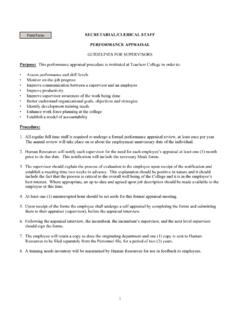Transcription of INTRODUCTION TO COMMUNICATION
1 Subject: Business COMMUNICATION (The Lesson is Up-dated and Converted into SIM Format By: Dr. Karam Pal) Course: MBA Course Code: CP 105 Lesson: 1 INTRODUCTION TO COMMUNICATION Objective: The main objective of this lesson is to make the students learn on the subject matter of the business COMMUNICATION vis- -vis its nature and importance. Structure Introductio n The Concept of COMMUNICATION significance of COMMUNICATION Nature of Business Communications: A Case Study Summary Key Words Self Assessment Exercise Suggested Readings INTRODUCTION You cannot not communicate.
2 This statement is quite often misunderstood by many of us. We may be fussy about the grammar of this sentence and that is at the cost of the its spirit. It, in fact, this statement let us know that we cannot remain without commutation even if we feel as we have not communicated anything but still we have commutated everything. If you are like the majority of us, you spend more time in communicating than doing anything else. Probably you spend a hefty part of each day in one-to-one speaking, writing and listening. When you are not talking or listening, you are presumably communicating in supplementary ways like - understanding, lettering, gesturing, and drawing.
3 Or perhaps, you are just taking in information by seeing, feeling, or smelling. All of these activities are forms of COMMUNICATION and certainly you do them right through most of your time. Obviously, such activity, which we are engrossed in so much, has to be significant. Perhaps, it is the most important of all our activities. It is easy to make out that COMMUNICATION is what has enabled us to develop the civilized society. It is one activity that we human beings clearly do better than the other creatures, and it basically explains our dominant role in this universe. COMMUNICATION has enabled us to organize - to work in groups; and through organization, we have been able to overcome barriers to our existence that we could not have subjugated individually.
4 But we need not discuss further how COMMUNICATION has contributed to our development as human beings. Its role is understandable to all of us. We have to articulate that COMMUNICATION is vital to our success and well-being in enlightened civilization. The Concept of COMMUNICATION The word COMMUNICATION has been derived from the Latin word 'communis' that means common . However, COMMUNICATION incorporates, besides commonality, the concepts of transfer, meaning and information. The COMMUNICATION can be defined as the process through which two or more persons come to exchange ideas and understanding among them.
5 The definition involves two aspects in COMMUNICATION : 2 First, there is something, which is transmitted, such as, facts, feelings, ideas, etc. It implies that there must be a receiver if COMMUNICATION is to occur. The sender of message must consider the receiver while structuring his message from a technical standpoint as well as in delivering it. When the receiver is not considered, there is either no response or there is wrong response. Second, the definition emphasizes the understanding element in the COMMUNICATION . Sharing of understanding would be possible only when the person, to whom the message is meant, understands it in the same sense in which the sender of the message wants him to understand.
6 Thus, COMMUNICATION involves something more than mere transmission of the message or transmission and physical receipt thereof. The correct interpretation of the message is important from the point of view of organizational efficiency. As such, the greater the degree of understanding present in the COMMUNICATION , the more the likelihood that human action will proceed in the direction of accomplishment of goals. How do we define COMMUNICATION ? " COMMUNICATION is something so simple and difficult that we can never put it in simple words," says Mathews. But we do need a definition to understand the term.
7 In his book COMMUNICATION in Business, Peter Little defines COMMUNICATION as follows: COMMUNICATION is the process by which information is transmitted between individuals and / or organizations so that an understanding response results. 3 Another very simple definition of ' COMMUNICATION ' has been provided by Newman and Summer Jr: COMMUNICATION is an exchange of facts, ideas, opinions, or emotions by two or more persons. 'Information' is the key word in the first definition COMMUNICATION consists in transmitting 'information'. But this definition does not indicate the objects about which information is to be transmitted.
8 This is precisely what is being done in the second definition. COMMUNICATION transmits information not only about tangible facts and determinable ideas and opinions but also about emotions. When a communicator passes on or transmits some information, he may also, either deliberately or unconsciously, be communicating his attitude or the frame of his mind. And sometimes the latter may be more relevant to the reality that is being communicated. Often we may have come across words of high praise spoken in a scoffing tone. In such a case, the words signify nothing and the tone is the real thing.
9 Similarly, high-sounding expressions of bravery may be only a mask to conceal a person's timidity and cowardice that may be betrayed by his facial expressions. The following definition offered by William Scott appear comprehensive and particularly satisfying to the students of 'business COMMUNICATION ' since it touches all aspects of the COMMUNICATION process: Managerial COMMUNICATION is a process which involves the transmission and accurate replication of ideas ensured by feedback for the purpose of eliciting actions which will accomplish organizational goals. This definition highlights four imperative points: 4 1.
10 The process of COMMUNICATION involves the COMMUNICATION of ideas. 2. The ideas should be accurately replicated (reproduced) in the receiver's mind, , the receiver should get exactly the same ideas as were transmitted. If the process of COMMUNICATION is perfect, there will be no dilution, exaggeration, or distortion of the ideas. 3. The transmitter is assured of the accurate replication of the ideas by feedback, , by the receiver's response, which is communicated, back to the transmitter. Here it is suggested that COMMUNICATION is a two way process including transmission of feedback.



